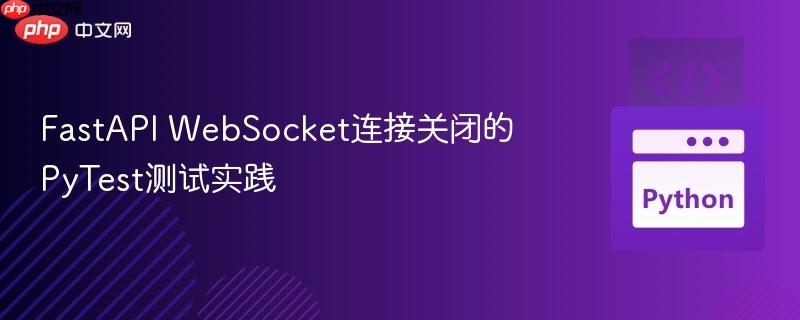
在使用FastAPI构建基于WebSocket的实时应用时,一个常见的需求是测试服务器在特定条件下主动关闭客户端连接的行为。例如,当客户端尝试连接到一个不存在的房间时,服务器应立即拒绝并关闭连接。PyTest是Python生态中流行的测试框架,结合FastAPI的TestClient,可以方便地对HTTP和WebSocket端点进行测试。
然而,测试WebSocket连接的关闭状态常常会遇到挑战。开发者可能会直观地尝试在建立连接的代码块外部使用pytest.raises(WebSocketDisconnect)来捕获异常,期望连接失败时立即抛出。然而,这种方法往往无法奏效,因为TestClient的websocket_connect方法可能成功建立底层TCP连接,但服务器端的WebSocket协议握手或业务逻辑处理随后导致连接关闭,此时异常并不会立即抛出。
考虑以下初始测试尝试及其返回的错误信息:
import pytest
from fastapi.testclient import TestClient
from fastapi.websockets import WebSocketDisconnect
# 假设app和get_manager以及override_manager已正确定义
# ... (省略了app和manager的依赖覆盖代码)
client = TestClient(app)
class TestWebsocketConnection:
def test_connect_to_non_existing_room_initial_attempt(self):
with pytest.raises(WebSocketDisconnect) as e_info:
with client.websocket_connect("/ws/non_existing_room") as ws:
# 尝试发送数据,但如果连接已关闭,可能不会立即触发异常
ws.send_json({"message": "Hello world"})
# 运行时可能返回:
# FAILED tests/test_websockets.py::TestWebsocketConnection::test_connect_to_non_existing_room - Failed: DID NOT RAISE <class 'starlette.websockets.WebSocketDisconnect'>这个错误表明,尽管我们预期会抛出WebSocketDisconnect,但实际并没有。这是因为WebSocketDisconnect通常在尝试对一个已经关闭的WebSocket连接进行读写操作时才会触发,而不是在连接建立的瞬间。
WebSocketDisconnect是Starlette(FastAPI底层使用的Web框架)中定义的异常,它标志着WebSocket连接的意外断开或服务器主动关闭。理解其触发机制是编写有效测试的关键:
因此,要测试连接是否已关闭,我们需要模拟客户端尝试与服务器通信的场景。
基于上述理解,测试WebSocket连接关闭的有效策略是:在尝试建立连接后,立即尝试从该WebSocket连接接收数据。如果服务器已经关闭了连接,那么这个接收数据的操作就会触发并抛出WebSocketDisconnect异常,我们就可以成功捕获它。
以下是实现这一策略的PyTest代码示例:
import pytest
from fastapi.testclient import TestClient
from fastapi.websockets import WebSocketDisconnect
from typing import Annotated
# 假设你的FastAPI应用和GameManager的定义如下
# src/game_manager.py
class GameManager:
def __init__(self):
self.games = {} # 存储游戏房间信息
async def connect(self, websocket, room_name, password):
if room_name not in self.games:
# 如果房间不存在,则抛出WebSocketDisconnect
raise WebSocketDisconnect(code=1008, reason="Room does not exist")
# 实际连接逻辑...
await websocket.accept()
print(f"Client connected to room: {room_name}")
# 这里为了测试,假设连接成功后不会立即发送数据
async def remove(self, websocket):
# 清理连接逻辑
print("Client disconnected.")
async def handle_message(self, room_name, client_id, data):
# 处理消息逻辑
pass
# src/main.py
from fastapi import FastAPI, APIRouter, Depends, WebSocket
from fastapi.routing import APIRoute
# 为了演示,这里简化get_manager
def get_manager() -> GameManager:
return GameManager()
app = FastAPI()
router = APIRouter()
@router.websocket("/ws/{room_name}")
@router.websocket("/ws/{room_name}/{password}")
async def websocket_endpoint(
websocket: WebSocket,
manager: Annotated[GameManager, Depends(get_manager)],
):
room_name = websocket.path_params["room_name"]
password = websocket.path_params.get("password", None)
try:
await manager.connect(websocket, room_name, password)
# client_id = websocket.scope["client_id"] # 实际应用中会获取
while True:
data = await websocket.receive_json()
# await manager.handle_message(room_name, client_id, data) # 实际应用中会处理
except WebSocketDisconnect:
await manager.remove(websocket)
except Exception as e:
print(f"Unexpected error: {e}")
await manager.remove(websocket)
app.include_router(router)
# tests/test_websockets.py
# 依赖覆盖,确保测试环境隔离且可控
async def override_get_manager() -> GameManager:
try:
# 尝试使用已存在的manager实例
yield override_get_manager.manager
except AttributeError:
# 如果不存在,则创建并初始化一个新的manager
manager = GameManager()
manager.games["foo"] = {} # 添加一个存在的房间用于其他测试
override_get_manager.manager = manager
yield override_get_manager.manager
# 将依赖覆盖应用到FastAPI应用
app.dependency_overrides[get_manager] = override_get_manager
client = TestClient(app)
class TestWebsocketConnection:
def test_connect_to_non_existing_room_correctly_closed(self):
"""
测试连接到不存在的房间时,连接是否被正确关闭。
通过尝试接收数据来触发WebSocketDisconnect异常。
"""
with pytest.raises(WebSocketDisconnect) as excinfo:
with client.websocket_connect("/ws/non_existing_room") as ws:
# 关键步骤:尝试从已关闭的连接接收数据
# 这将触发并捕获WebSocketDisconnect异常
ws.receive_json()
# 可选:进一步断言异常的详细信息,例如错误码或原因
assert excinfo.type is WebSocketDisconnect
assert excinfo.value.code == 1008
assert "Room does not exist" in excinfo.value.reason在这个示例中,ws.receive_json()是关键。当客户端尝试连接到/ws/non_existing_room时,服务器端的manager.connect方法会检测到房间不存在,并立即抛出WebSocketDisconnect。websocket_endpoint捕获此异常后,会执行清理逻辑(manager.remove),但不会向客户端发送任何数据。此时,客户端的WebSocket连接实际上已经被服务器关闭。当客户端代码执行到ws.receive_json()时,由于连接已关闭,它会检测到这一点并抛出WebSocketDisconnect,从而被pytest.raises成功捕获。
通过理解WebSocketDisconnect异常的触发时机,并采用在连接建立后尝试接收数据的策略,我们可以有效地在FastAPI应用中使用PyTest测试WebSocket连接的关闭情况。这种方法不仅能够准确捕获预期的异常,还能帮助开发者验证服务器端在特定业务逻辑下对WebSocket连接的正确管理。
以上就是FastAPI WebSocket连接关闭的PyTest测试实践的详细内容,更多请关注php中文网其它相关文章!

每个人都需要一台速度更快、更稳定的 PC。随着时间的推移,垃圾文件、旧注册表数据和不必要的后台进程会占用资源并降低性能。幸运的是,许多工具可以让 Windows 保持平稳运行。

Copyright 2014-2025 https://www.php.cn/ All Rights Reserved | php.cn | 湘ICP备2023035733号